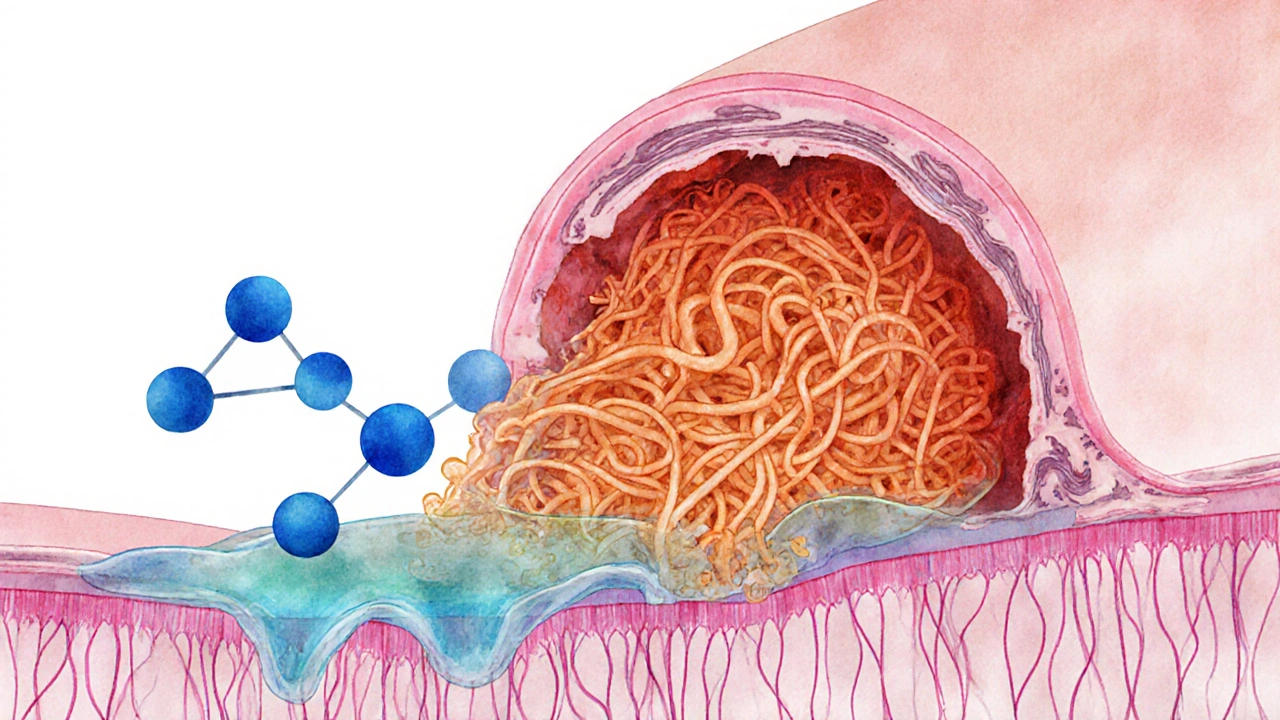Mucolytic Agent Selector
Recommended Mucolytic Agent
Detailed Comparison
Key Takeaways
- Carbocisteine works by thinning mucus without strong irritation, making it gentle for long‑term use.
- Acetylcysteine offers rapid mucus breakdown but can cause a sulfurous taste and bronchospasm.
- Bromhexine and ambroxol share a similar mechanism (increasing serous secretions) and are often used for acute cough.
- Guaifenesin, an OTC option, is less potent but useful for mild congestion.
- Choosing a mucolytic depends on disease severity, side‑effect tolerance, and whether a prescription is needed.
When it comes to clearing thick airway secretions, Carbocisteine often lands in the conversation alongside a handful of older and newer mucolytic agents. This guide breaks down how carbocisteine stacks up against the most common alternatives, helping you decide which product fits a specific respiratory condition, dosage preference, or safety profile.
What Is Carbocisteine?
Carbocisteine is a synthetic derivative of the amino acid L‑cysteine that belongs to the class of mucolytic agents. It was first introduced in the 1960s and is widely prescribed in Europe, Asia, and parts of South America for chronic bronchitis, COPD, and post‑viral cough.
How Carbocisteine Works
The drug modifies the structure of mucin glycoproteins, reducing disulfide bonds that make mucus viscous. Unlike some mucolytics that directly break these bonds, carbocisteine promotes the production of thinner, more watery secretions while preserving the protective mucus layer. This gentle action translates to fewer reports of cough irritation or bronchospasm.

Typical Indications
Physicians usually prescribe carbocisteine for:
- Chronic bronchitis with productive cough
- Stable COPD as an adjunct to bronchodilators
- Upper respiratory infections where mucus is thick and hard to expectorate
- Pre‑ and post‑operative airway management in patients at risk of secretion buildup
Common Alternatives
Below are the main mucolytic agents that clinicians compare against carbocisteine. Each entry includes a brief definition with microdata for the first mention.
Acetylcysteine is a classic mucolytic that directly cleaves disulfide bonds in mucus, rapidly reducing viscosity. It’s available as oral tablets, effervescent powders, and inhalation solutions.
Bromhexine is a synthetic alkaloid that stimulates serous gland secretion, making mucus less sticky. It’s commonly sold in 8mg tablets or syrup.
Ambroxol is the active metabolite of bromhexine, offering a slightly stronger secretolytic effect and a mild local anesthetic action that can soothe irritated airways.
Guaifenesin is an over‑the‑counter expectorant that increases the volume of bronchial secretions, helping thin mucus through a different pathway-enhancing water content rather than breaking bonds.
Mucolytic agents as a group cover a range of substances that aim to improve mucus clearance, each with its own pharmacodynamic profile and safety considerations.
Side‑Effect Profiles at a Glance
Side effects often dictate which drug a patient can tolerate.
- Carbocisteine: mild gastrointestinal upset, rare skin rash.
- Acetylcysteine: sulfur‑like aftertaste, nausea, potential bronchospasm in asthmatics.
- Bromhexine: occasional dyspepsia, headache.
- Ambroxol: rare allergic reactions, taste alteration.
- Guaifenesin: generally well tolerated; high doses may cause dizziness.
Direct Comparison Table
| Agent | Mechanism | Typical Indications | Common Dosage Form | Usual Adult Dose | Onset of Action | Key Side Effects |
|---|---|---|---|---|---|---|
| Carbocisteine | Alters mucin structure, reduces disulfide cross‑linking | Chronic bronchitis, COPD, post‑viral cough | Oral syrup, tablets | 750mg 2-3×/day | 4-6hours | GI upset, mild rash |
| Acetylcysteine | Directly cleaves disulfide bonds | Acute bronchitis, mucous plugging, acetaminophen overdose | Effervescent tablets, inhalation solution | 600mg 3×/day (oral) or 3-5mL nebulized | 30minutes | Sulfur taste, nausea, bronchospasm |
| Bromhexine | Stimulates serous gland secretion | Acute cough, bronchitis | Tablets, syrup | 8mg 3×day | 1-2hours | Dyspepsia, headache |
| Ambroxol | Metabolite of bromhexine; secretolytic + local anesthetic | Chronic bronchitis, COPD | Tablets, syrup, inhalation | 30mg 2×day | 1-2hours | Allergic rash, taste change |
| Guaifenesin | Increases bronchial fluid volume | Mild to moderate cough, cold | OTC tablets, liquid | 200-400mg every 4hours | 1-3hours | Dizziness, GI upset (high dose) |

Decision Criteria: Which Mucolytic Suits You?
Use the following checklist to match patient needs with drug characteristics.
- Speed of relief needed - If rapid mucus breakdown is critical (e.g., pre‑operative airway clearance), acetylcysteine’s quick onset may be preferred.
- Tolerance for taste or odor - Patients who dislike the sulfuric aftertaste of acetylcysteine often switch to carbocisteine or ambroxol.
- Prescription vs. OTC - Guaifenesin is widely available without a prescription, making it the go‑to for mild symptoms.
- Chronic vs. acute use - Carbocisteine and ambroxol are better suited for long‑term management because they cause fewer irritative side effects.
- Comorbid conditions - Asthmatics should avoid acetylcysteine if they have a history of bronchospasm; carbocisteine is generally safer.
Practical Tips & Precautions
- Always take mucolytics with plenty of water; hydration boosts their effectiveness.
- Never combine oral mucolytics with strong antitussives unless advised-thick mucus needs a way out.
- Check for drug‑drug interactions: carbocisteine has minimal CYP involvement, but acetylcysteine can affect nitroglycerin metabolism.
- Pregnant or breastfeeding patients should discuss safety; most mucolytics are category B, but data are limited.
- For children under 12, dosage adjustments are required; many agents are not approved for pediatric use.
When to Seek Professional Advice
If you experience any of the following, stop the medication and contact a healthcare provider:
- Sudden worsening of dyspnea or wheezing
- Severe skin rash or hives
- Persistent nausea or vomiting that interferes with nutrition
- Unexplained fever after starting a mucolytic
A clinician can reassess the underlying condition, adjust the dosage, or switch to a more suitable agent.
Frequently Asked Questions
Can I use carbocisteine and acetylcysteine together?
Combining two mucolytics rarely adds benefit and may increase side‑effects. Most physicians recommend choosing one based on the clinical situation.
Is carbocisteine available in the United States?
Carbocisteine is not FDA‑approved for marketing in the U.S., so it’s generally accessed through international pharmacies or clinical trials.
How long does it take to see improvement with carbocisteine?
Most patients notice a softer cough and easier expectoration within 4-6hours after the first dose, but full benefits may require several days of consistent use.
Are there natural alternatives to these mucolytics?
Steam inhalation, honey, and adequate hydration can aid mucus clearance, but they lack the targeted biochemical action of pharmaceutical mucolytics.
What should I do if I miss a dose?
Take the missed dose as soon as you remember, unless it’s close to the next scheduled dose. In that case, skip the missed one and resume the regular schedule-don’t double‑dose.
Choosing the right mucolytic is a balance of efficacy, speed, safety, and convenience. By comparing carbocisteine with its most common peers, you can pinpoint the agent that matches your respiratory needs while minimizing unwanted effects. Always discuss any medication change with a qualified clinician to ensure optimal outcomes.


Carbocisteine is a solid choice for gentle mucus relief.
When you think carbocisteine is the holy grail of mucolytics you are deluding yourself. It claims to be gentle, but that gentleness often translates to sluggish action when you need rapid clearance. The rapid onset of acetylcysteine is a glaring advantage in acute settings, yet you hear endless praise for carbocisteine’s safety profile. Do you really want to wait four to six hours for any noticeable effect? The bitter truth is that many patients never feel a difference before their cough worsens. Carbocisteine’s modest side‑effect list looks appealing, but mild GI upset can still derail therapy in frail individuals. Its mechanism of altering mucin cross‑linking is subtle, and that subtlety can be a double‑edged sword. In chronic bronchitis, that subtlety may help maintain the protective mucus layer, but in an acute exacerbation it may be insufficient. The table you posted shows a clear lag compared with the 30‑minute hit of NAC. If you are an asthmatic prone to bronchospasm, steering clear of acetylcysteine makes sense, yet carbocisteine is not magically bronchospasm‑free. Pharmacists often recommend ambroxol for its dual secretolytic and anesthetic properties, a nuance carbocisteine lacks. The over‑the‑counter guaifenesin is harmless but also weak, a fact many dismiss as “just for mild coughs.” You must weigh the cost‑benefit ratio; carbocisteine is pricier in many markets without delivering superior outcomes. The absence of a sulfur taste is nice, but taste is a trivial concern compared to clinical efficacy. In the end, the choice hinges on whether you value speed over safety, and that decision cannot be made on marketing fluff alone.
i think it helps to remember that mucolytics aren't one‑size‑fits‑all. carbocisteine works best when you're dealing with chronic, sticky mucus that you can't clear quickly. for acute flare‑ups, you may want something with faster onset like acetylcysteine. also, staying well hydrated amplifies any mucolytic effect – water thins the secretions naturally. a little note: watch out for the occasional mild rash or stomach upset, it's not common but can happen.
Hey folks, just a quick heads‑up – always pair your mucolytic with plenty of water 😊. It makes the medicine work better and keeps your throat from getting dry.
Good point about hydration. I would also add that taking the drug with food can reducde stomach upset, especially for carbocisteine. In my experience, spacing the dose about 4‑5 hours apart gives a smoother effect. Definately keep an eye on any rash, even if it's rare.
Don't be fooled by the pharma lobby pushing acetylcysteine as the only fast‑acting option. They profit from hype while ignoring the quiet benefits of carbocisteine for long‑term health.
Your blind trust in mainstream meds is exactly why patients suffer. The industry hides the truth about slower‑acting drugs that actually protect the airway lining.
Hydration is key when using any mucolytic; water thins secretions and enhances drug action. Also, avoid strong antitussives unless a doctor advises, because they can trap mucus.
If you crave drama, pick acetylcysteine and enjoy the sulfuric punch; carbocisteine is for the faint‑hearted who prefer a slow‑burn soothing their cough.
Both carbocisteine and guaifenesin have their place depending on symptom severity.